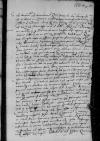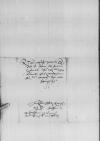Ubi te, abiens, in ⌊caesaris⌋ aula reliqui, contendi velis remisque ad illustrissimum dominum ⌊ducem⌋. Domi quam(?) dies quinque non sum moratus et ad serenissimum et clementissimum meum dominum, dominum ⌊Foedericum⌋ ⌊Daniae⌋ regem, me contuli. ⌊Ei⌋, quod communis cum socero cum[] genero on the margin⌈cum hidden by binding⌈[] hidden by binding⌉ generocum[] genero on the margin⌉ causa est, aperui, quos isthinc abiens ex re utriusque perspecta habebam. ⌊Regi⌋ Tuae Benignitatis erga se officia pergrata fuere visusque est mihi Brandeneri legationem iam tum primum iudicavisse. Civitates legatum hactenus Brandenerum superinscribed in place of crossed-out ...⌈... illegible⌈...... illegible⌉Brand(enerum)Brandenerum superinscribed in place of crossed-out ...⌉ ⌊Foederici⌋ voluntate de postulatis distulere et nunc primum eius assensu consensum est in tractatum magis perendinandi, quam constituendi, quod video studio, ea tamen lege, quod omnia, antequam recipiantur, referantur ad ⌊Foedericum⌋. Manus illa in ⌊Frisiis⌋ ne tantillum animum ⌊Frederici⌋ deiecit, et si ⌊Christiernum⌋ illam in suas partes sollicitare non sit obscurum, si quando Christierno pars illius exercitus sacramento militari adstringetur, pars Foederica written over um⌈umaa written over um⌉ non minus libenter sequetur. Sciunt et hi superinscribed in place of crossed-out Ulixi⌈Ulixihihi superinscribed in place of crossed-out Ulixi⌉ ⌊Ulixis⌋ technas et Graecas artes, et leoninae assuere vulpinam[1]. In qua re pudor maior est iactatio, quam providentia.
Civitates cum ⌊Foedrico⌋ unam agunt causam, ita adstrictae written over i⌈iaeae written over i⌉, ut frustra sit temptare discidium. Causae, ut ego pro mea imprudentia video, impar est legatus Brandenerus gentis causae agendi written over a⌈aii written over a⌉(?) pro magnitudine, imbecillior istius, quod written over quam⌈quamquodquod written over quam⌉ cogitant ... illegible⌈...... illegible⌉, divortii atque ignoratior.
Mirandum hic gratiosus apud efferos ⌊Saxones⌋ et princeps salutari iucundum duxit. Habuit hominem, qui ad eam rem ei subpari superinscribed⌈ii superinscribed⌉[...] paper damaged⌈[...][...] paper damaged⌉aretur et vocaret comitem prognatum caesaris ⌊Maximiliani⌋ et his ... illegible⌈...... illegible⌉ vulgus iactat tractari negotium per notum caesaris. Caesari, ut debeo, faveo, hominis ignaviae invideo. Apud meos ⌊municipes Hamburgenses⌋ reiectus est, quia infrugi indicarent de ea re restituenda tractare, cuius apud eos potestas non esset neque accessisset, quod restituerent umquam(?) receptum(?) scilicet(?) regnum, habitus tum est propter ⌊caesarem⌋  BCz, 1595, p. 334 reverenter. De his, si continget, quod credo, me ad Tuam Benignitatem redire, plura. Nunc tollere manum praetor de tabula iubet.
BCz, 1595, p. 334 reverenter. De his, si continget, quod credo, me ad Tuam Benignitatem redire, plura. Nunc tollere manum praetor de tabula iubet.
A serenissimo ⌊rege Daniae⌋ dimissus sum cum commendatione ad ⌊ducem generum⌋. Navigavi ex ⌊theloneo Helschenoro⌋ in ⌊Cimbris⌋, ubi freto ⌊Sermaticus(!) Oceanus⌋ cum ⌊Britannico⌋ coit, paene obrutus irato ⌊Neptuno⌋ furentibus nimbis, servatus tamen Dei munere. Ignivoma quaedam caeli fax porrecta ab Ursulis in Boream diem ante, atque post hidden by binding⌈[t]t hidden by binding⌉ exortos nimbos praenuntia fuit tempestatis per noctem. ⌊Gedanum⌋, patriam tuam, applicui. ⌊Hic⌋ veni in notitiam recreato hidden by binding⌈[ato]ato hidden by binding⌉ me post nauseam maris cum quodam adolescente ⌊Bartho hidden by binding⌈[o]o hidden by binding⌉lomeo Senger⌋, cui ⌊filia⌋ ⌊sororis⌋ tuae nupta est. Hic me in suis aedibus perhumaniter Tuae Benignitatis nomine habuit hidden by binding⌈[it]it hidden by binding⌉. Invitavit me et ⌊mater⌋ tua, mulier honestissima atque alte hidden by binding⌈[lte]lte hidden by binding⌉ra quaedam ⌊Hecuba⌋. Fuere et ibi sorores tuae, magna [...] hidden by binding⌈[...][...] hidden by binding⌉ laetitia audivere, quod a te venerim. Incredibile est omnium tuorum tui desiderium. Beabit omnes Gratia Tua, si quo[...] hidden by binding⌈[...][...] hidden by binding⌉ poteris ex nassa legationis tuae aliquando ad eos erumpere hidden by binding⌈[re]re hidden by binding⌉.
Ceterum, mi Domine, quae de ⌊comitiis⌋, ⌊Spirae⌋ ad XV August[i] indictis per ⌊caesarem⌋ isthinc abiens, ferebantur, nescio an hidden by binding⌈[n]n hidden by binding⌉ consequentur. Apud ⌊Fredericum⌋ ⌊Daniae⌋ rogatus de ea re respondi, quae cognovi, sed quia dicebat mihi, neque se, neque alios adhuc principes eo esse vocatos, haeremus atque a[...] hidden by binding⌈[...][...] hidden by binding⌉ pendemus. Si mihi esset redeundum missione domini ⌊ducis⌋, id quod Benignitas Tua praesagiebat, praestaret omnino scire, tamen haud dubie res intra paucos dies erit comper hidden by binding⌈[r]r hidden by binding⌉tior. Bene spero illustrissimum ⌊ducem⌋ meum adventum boni hidden by binding⌈[ni]ni hidden by binding⌉ consulturum, qui tam magnis patronis commendatus venio hidden by binding⌈[enio]enio hidden by binding⌉(?).
Ita me obstrinxit sibi Gratia Tua, ut si effudero quique(?) umquam in me est studii, officiorum et obsequii{i}, nullam tamen partem meritorum tuorum videar assecutus. Vehementerque rogo, ut tua benignitate et patrocinio me semper prosequare, et clientem tuum Rheyneckium et servitorem non dedignaris hidden by binding⌈[ris]ris hidden by binding⌉.
Equidem, si bonis condicionibus is princeps me dignabitur, ea sum sententia, ut ex fide et integritate ... illegible⌈...... illegible⌉ ei, quod mihi est, aut diligentiae, aut operae libenter impendam.
Servitium meum commendo Gratiae Tuae.
 BCz, 1595, p. 334 reverenter. De his, si continget, quod credo, me ad Tuam Benignitatem redire, plura. Nunc tollere manum praetor de tabula iubet.
BCz, 1595, p. 334 reverenter. De his, si continget, quod credo, me ad Tuam Benignitatem redire, plura. Nunc tollere manum praetor de tabula iubet. 


